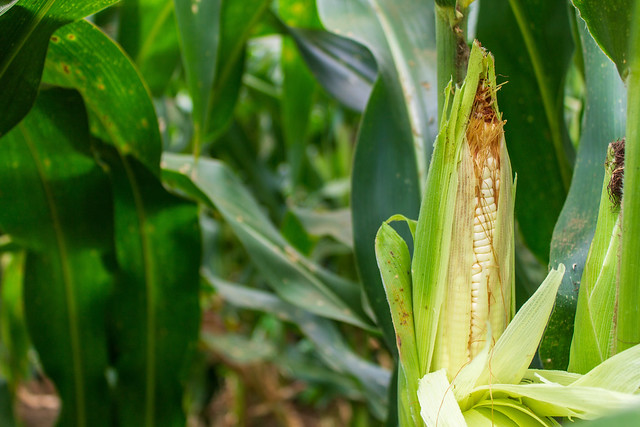The first hybrid variety of zinc maize is now available in Colombia—and it offers opportunities for additional nutrition and income for the country’s coffee farmers.
Such health-boosting varieties of maize are aimed at resource-poor families or rural communities who rely on staple crops for much of their diet—because they are often deficient in essential vitamins and minerals. Zinc plays an essential role in maintaining optimal childhood growth and a healthy immune system. In Colombia, 13 percent children under five in are stunted.
By enhancing the micronutrient content of staple crops like maize, regular consumption improves nutrition and health.
The SGBIOH2 variety was developed by HarvestPlus and the International Maize and Wheat Improvement Center (CIMMYT) by crossing high-yielding varieties with more nutritious ones using a process known as biofortification. Thanks to the biodiversity of the CIMMYT seed bank in Mexico, conventional plant breeding methods were used. The work was supported by the National Federation of Coffee Growers (FNC) and the seed company Semillas Guerrero Asociados (SGA Semillas). When the variety launched earlier this month in Pereira, Risaralda, representatives of the Colombian Ministry of Agriculture and more than 200 coffee growers from the Colombian coffee region were in attendance to celebrate.
“SGBIOH2 has a high zinc content, 28 percent more than regular maize, and has a potential yield higher than 10 tons/acre (8,921.79 pounds/acre) in the Colombian coffee zone. It is also tolerant to diseases such as gray spot and has crystalline (hard texture) grain demanded by the national industry,” said Luis Narro, scientific consultant for CIMMYT in Colombia.
The release of this variety gives farmers a choice between this higher-yielding hybrid (which must be repurchased annually) or a lower-yielding variety that can be replanted for several seasons, made available in early 2018. Since HarvestPlus began operating in Latin America and the Caribbean in 2012, varieties of vitamin A cassava, maize, and sweet potato, as well as iron beans and cowpeas (black-eyed peas) have become available to families across Latin America, including Brazil, Colombia, Nicaragua, El Salvador, Guatemala, Panama, and Honduras.
“Arepas (corn cakes) made with this new hybrid can be considered a good source of zinc, since the daily consumption of a zinc-biofortified maize arepa would provide up to two times more zinc than those made with commercial maize,” said Marilia Nuti, director of Latin America and the Caribbean for HarvestPlus.
A new maize, friend of coffee growers
In Colombia more than 540,000 families are dedicated to coffee production. Ensuring its economic sustainability is one of the main missions of the National Federation of Coffee Growers (FNC).
“This hybrid is of special importance for coffee growers, said Hernando Duque, technical manager of the FNC. “In addition to adapting to the Colombian coffee zone, between 1,000–1,600 meters (3281–5249 ft) of altitude, it has a high potential yield of up to 10 tons per hectare (20,000 pounds/acre) and is resistant to diseases such as cercospora (a fungi). Most importantly, it is a real opportunity to generate greater income for coffee growers. Up to two maize harvests can be done before the first coffee harvest, in the lots renewed by sowing conventional zoca (the stem of the coffee plant).”
Getting this seed into the hands of coffee growers is a task that will be carried out in partnership with the Colombian company Semillas Guerrero Asociados that will sell bags of 60,000, 6,000 and 3,000 seeds from now on.
Focusing on nutritional security
The release coincides with increasing focus on food security as part of a strategic plan presented at Agroexpo 2019 in July called Maíz para Colombia. This nutritional security component of the plan hopes 50 percent of the population will be consuming zinc-biofortified maize by 2030. Achieving this makes it a priority to have an alliance between the public and private sectors and civil society to increase the demand for nutritious and productive maize in Colombia.
To help ensure this, a working meeting was convened with 30 representatives of entities and organizations committed to the nutrition of Colombians and interested in implementing what is known as “Maize for Colombia.”
“The goal is to move from concern to putting hands to work, to ensure the team of Colombia maize growers can increase their incomes and consumers enjoy healthy and nutritious food,” said Bram Govaerts, Director of the Integrated Development program and CIMMYT’s regional representative for the Americas.
Learn more about all the biofortified crops in Colombia by visiting www.biofortificados.com.
